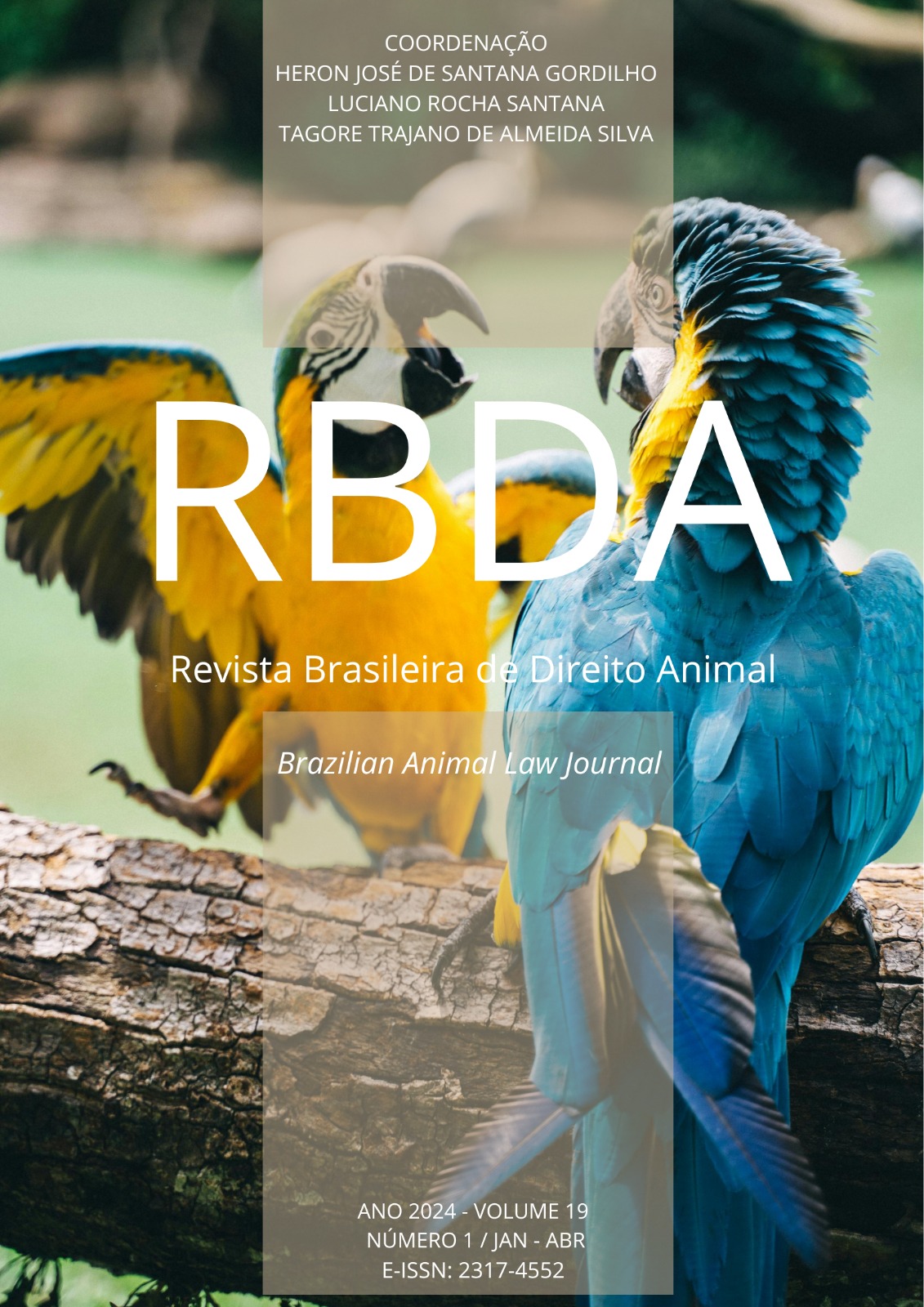O VIÉS ANTROPOMÓRFICO: INTERFACES DO ESPECISMO NA UTILIZAÇÃO DA INTELIGÊNCIA ARTIFICIAL EM ANIMAIS NÃO-HUMANOS E A EMERGÊNCIA DA ÉTICA ALGORITMICA PAUTADA NA EXPERIÊNCIA DO DIREITO ANIMAL
DOI:
https://doi.org/10.9771/rbda.v19i0.61944Palavras-chave:
Antropocentrismo, Direito Animal, Especismo, Inteligência Artificial, SenciênciaResumo
O presente artigo visa investigar o caráter antropocêntrico humano no que tange a atuação da Inteligência Artificial (IA) em animais não-humanos e avaliar a emergência de uma ética algorítmica voltada a estes. Partimos do seguinte problema: como o viés antropomórfico influencia a implementação da IA em animais não-humanos e de que forma a ética algorítmica pode ser desenvolvida e aplicada para mitigar o especismo, considerando a experiência e os princípios do Direito Animal? Partimos da hipótese de que os valores humanos majoritariamente são especistas, então a IA reproduzirá tais entendimentos e em que pese a IA seja apresentada como ferramenta emancipadora ela ainda opera visando objetivos benéficos para humanos. Os objetivos específicos são três: a) compreender o atual status jurídico dos animais não-humanos e a terminologia da “senciencia”; b) avaliar de quais maneiras a IA impacta contemporaneamente os animais não-humanos; e, c) vislumbrar qual o fator ideológico que oblitera tais processos e perspectivas éticas. Termina confirmando a hipótese. Por fim, a presente pesquisa surgiu a partir da técnica de investigação teórica, seu método procedimental e de abordagem são qualitativos. Se trata de uma pesquisa do tipo exploratória a partir da técnica bibliográfica-documental. A metodologia desenvolvida logo, é a hipotético-dedutiva.
Downloads
Referências
AMODEI, D. et al. Concrete problems in AI safety. Arxiv, vol. 01, 2016. DOI: https://doi.org/10.48550/arXiv.1606.06565
ANDRADE, Fernanda; ZAMBAM, Neuro José. A condição de sujeito de direito dos animais humanos e não humanos e o critério da senciência. Revista Brasileira de Direito Animal, vol. 11, n° 23, 2016, p. 143-171. DOI: https://doi.org/10.9771/rbda.v11i23.20373.
ATAÍDE JUNIOR, Vicente de Paula; LIMA, Yuri Fernandes. TEORIA DAS CAPACIDADES JURÍDICAS ANIMAIS. Revista Brasileira de Direito Animal, vol. 19, n° 02, 2024. DOI: https://doi.org/10.9771/rbda.v19i0.59041.
BARTLETT, Steven J. Raízes da resistência humana aos direitos dos animais: Bloqueios psicológicos e conceituais. Revista Brasileira de Direito Animal, vol. 02, n° 03, p. 17-66, 2007. DOI: https://doi.org/10.9771/rbda.v2i3.10357.
BASTOS, Elísio Augusto Velloso. Direitos para os animais não-humanos? Algumas teorias filosóficas a respeito. Revista Brasileira de Direito Animal, vol. 13, n° 02, 2018. DOI: https://doi.org/10.9771/rbda.v13i2.27933.
BATESON, P. Assessment of pain in animals. Anim. Behav,1991. DOI: https:// doi. org/ 10. 1016/ S0003- 3472(05) 80127-7.
BELCHIOR, Garmana Parente Neiva; DIAS, Marian Ravely Martins Soares. OS ANIMAIS DE ESTIMAÇÃO COMO MEMBROS DO AGRUPAMENTO FAMILIAR. Revista Brasileira de Direito Animal, vol. 15, n° 03, 2020. DOI: https://doi.org/10.9771/rbda.v15i3.38788.
BENDEL, O. Advanced driver assistance systems and animals. Künstl Intell, 2014, p. 263–269. DOI: 10.1007/s13218-014-0332-1.
BLATTNER, Charlotte. An Assessment of Recent Trade Law Developments from an Animal Law Perspective: Trade Law as the Sheep in Wolf’s Clothing, Animal Law Review, 2016. Disponível em: https://law.lclark.edu/live/files/32129-22-2-blattnerpdf. Acesso em: 20 maio 2024.
BRASIL. Lei nº 10.406, de 10 de janeiro de 2002. Institui o Código Civil. Diário Oficial da União. Brasília, DF, 2002. Disponível em: https://www.planalto.gov.br/ccivil_03/leis/2002/l10406compilada.htm. Acesso em: 20 maio 2022.
BROWN, Donald E. Human Universals. New York: McGraw-Hill, 1991.
BORGES, Daniel Moura. A DECLARAÇÃO UNIVERSAL DOS DIREITOS DOS ANIMAIS: SUA APLICAÇÃO ENQUANTO SOFT LAW E HARD LAW. Dissertação de Mestrado. Programa de Pós-graduação em Direito da Universidade Federal da Bahia, 2015. Disponível em: https://repositorio.ufba.br/handle/ri/18719. Acesso em: 15 maio 2024.
BOSTROM, N. Superintelligence: Paths, Dangers, Strategies. Oxford: Oxford University Press, 2014.
CHANG, C. et al. Applying artificial intelligence (AI) techniques to implement a practical smart cage aquaculture management system. J. Med. Biol. Eng., 2021, p. 652–658. DOI: https://doi.org/10.1007/s40846-021-00621-3
CHENG, Y. A development architecture for the intelligent animal care and management system based on the internet of things and artificial intelligence. International Confer ence on Artificial Intelligence in Information and Communication (ICAIIC), 2019. DOI: https://doi.org/10.1109/ICAIIC.2019.8669015
CHESSMAN, Christian F. NOT QUITE HUMAN: ARTIFICIAL INTELLIGENCE, ANIMALS, AND THE REGULATION OF SENTIENT PROPERTY. SSRN, 2018. DOI: http://dx.doi.org/10.2139/ssrn.3200802.
CHIESA, Luis E. Why Is It a Crime to Stomp on a Goldfish? Harm, Victimhood and the Structure of Anticruelty Offenses. Mississippi Law Journal, 2008. Disponível em: https://digitalcommons.pace.edu/lawfaculty/480/. Acesso em: 20 maio 2024.
CHRISTINE, K. Fellow creatures: our obligations to the other animals. Oxford: Oxford University Press, 2018.
COGHLAN, Simon; PARKER, Christine. Harm to Nonhuman Animals from AI: a Systematic Account and Framework. Philosophy & Technology, 2023. DOI: https://doi.org/10.1007/s13347-023-00627-6
CORNOU, C. Automation systems for farm animals: Potential Impacts on the human AND animal relationship and on animal welfare. Anthrozoös, 2009, p. 213–220. DOI: https://doi.org/10.2752/175303709X 457568.
COSTA, Deborah Regina Lambach Ferreira; FERREIRA, Fabiano Montiani. O direito dos animais de companhia. Revista Brasileira de Direito Animal, vol. 13, n° 02, 2018, p. 24-39. DOI: https://doi.org/10.9771/rbda.v13i2.27939.
DARWIN, C. R. The descent of man, and selection in relation to sex. London: John Murray. Volume 1. 1st edition, 1871.
DEGELING, C.; LEDERMAN, Zohar; ROCK, Melanie. Culling and the common good: Re-evaluating harms and benefits under the one health paradigm. Public Health Ethics, 2016, p.244–254. DOI: 10.1093/phe/phw019.
EZANNO et al. Research perspectives on animal health in the era of artificial intelligence. Veterinary Research, 2021. DOI: https://doi.org/10.1186/s13567-021-00902-4
FIGUEIREDO, Carla Regina; CABRAL, Flávio Garcia. Inteligência artificial: machine learning na Administração Pública. International Journal of Digital Law, n° 01, 2020. DOI: 10.47975/IJDL/1figueiredo.
FRANCIONE, Gary L. Animals, Property & the Law. Filadélfia: Temple U Press, 1995.
FORNASIER, Mateus de Oliveira; TONDO, Ana Lara. Experimentação Animal na Indústria de cosméticos e teoria do direito: uma análise sistêmica dos “direitos humanos dos animais”. Revista Brasileira de Direito Animal, vol 12, n° 02, 2017, p. 43-82. DOI: https://doi.org/10.9771/rbda.v12i02.22943.
FUENTES, S. et al. Artificial intelligence applied to a robotic dairy farm to model milk productivity and quality based on cow data and daily environmental parameters. Sensors, 2020. DOI: https://doi.org/10.3390/s20102975.
GERAQUE, Eduardo. Inteligência artificial reduz uso de animais em testes de laboratório. Revista Veja, 2019. Disponível em: https://www.uol.com.br/vivabem/noticias/redacao/2019/07/19/inteligencia-artificial-reduz-uso-de-animais-em-testes-de-laboratorio.htm. Acesso em: 10 maio 2024.
GONÇALVES, Carlos Roberto. Direito civil esquematizado. São Paulo: Saraiva, 2012.
HARRIS, E. E. Ancestors in our genome: the new science of human Evolution. Oxford: Oxford University Press, 2015.
HARTUNG, Thomas. Opinion: AI Beats Animal Testing at Finding Toxic Chemicals. The Scientist Magazine. Disponível em: https://www.the-scientist.com/opinion--ai-beats-animal-testing-at-finding-toxic-chemicals-65795. Acesso em: 25 maio 2024.
HORTA, O. The scope of the argument from species overlap. Journal of Applied Philosophy, 2014, p. 142–154. DOI: https://doi.org/10.1111/japp.12051
HORTA, O. What is speciesism? Journal of Agricultural and Environmental and Ethics, 2010, p. 243–266. DOI: https://doi.org/10.1007/s10806-009-9205-2.
LEITÃO, Alexandra. Os espetáculos e outras formas de exibição de animais. In: DUARTE, Maria Luísa; GOMES, Carla Amado (Coords). Direito (do) Animal. Coimbra: Almedina, 2016.
LUHMANN, Niklas. Ecological Communication. Chicago: The University of Chicago Press, 1989.
LUPTON, Deborah. From human-centric digital health to digital One Health: Crucial new directions for mutual flourishing. DIGITAL HEALTH, 2022. DOI: https://doi.org/10.1177/20552 076221129103.
MANCINI, C. Animal-computer interaction: A manifesto. Interactions, 2011, p. 69–73. DOI: 10.1145/1978822.1978836.
MANCINI, T., MARATEA, M., RICCA, F. Experimental evaluation of algorithms for solving problems with combinatorial explosion In: MANCINI T., MARATEA, M., RICCA, F (eds) AI Communications, vol. 29, n° 02, 2016. DOI: https://doi.org/10.3233/AIC-160701.
MCDOUGAL, Tony. Could AI robotics revolutionise poultry processing in the US? Poultry World, 2023. Disponível em: https://www.poultryworld.net/the industrymarkets/processing/artificial-intelligent-robotic-automation-set-to-revolutionise-poultry-processing-in-us/. Acesso em: 17 maio 2023.
MEDEIROS, Fernanda Luiza Fontoura; ALBUQUERQUE, Letícia. Experimentação animal: um combate jurídico nas universidades brasileiras. Revista Internacional Interdisciplinar INTERthesis. vol. 12, n° 01, 2015. p. 65-83. DOI: https://doi.org/10.5007/1807-1384.2015v12n1p65.
NACONECY, Carlos. Ética & animais: um guia de argumentação filosófica. Porto Alegre: Edipucrs, 2006.
PETER, S. Animal liberation, New York: Harper Perennial, 1975.
PLUHAR, E. B. Beyond prejudice: The moral significance of human and nonhuman animals. Durham: Duke University Press, 1995.
REDAÇÃO TERRA. Sistema Usa Inteligência Artificial para detectar animais selvagens em estradas. Terra, 2024. Disponível em: https://www.terra.com.br/planeta/sistema-usa-inteligencia-artificial-para-detectar-animais-selvagens-em-estradas,5647d161d69ce1abca35708476a21ad8f8yuc8pq.html?utm_source=clipboard. Acesso em: 20 maio 2024.
RUSSEL, Stuart; NORVIG, Peter. Artificial Intelligence: A Modern Approach. 3ª Ed, Pearson Eduacation. New Jersey: Prentice Hall, 2009.
SADEGHI, M. et al. An intelligent procedure for the detection and classification of chick ens infected by clostridium perfringens based on their vocaliza tion. Braz. J. Poult. Sci., 2015, p. 537–544. DOI: https://doi.org/10.1590/1516-635X1704537-544
SANDERS, Bas. “Global Animal Slaughter Statistics & Charts. Faunalytics, 2020. Disponível em: https://faunalytics.org/global-animal-slaughter-statistics-and-charts-2020-update/. Acesso em: 15 maio de 2023.
SCANLON, T. What We Owe to Each Other. Cambridge: Belknap Press, 2000.
SEBO, J. Saving animals, saving ourselves: Why animals matter for pandemics, climate change, and other catastrophes. Oxford: Oxford University Press, 2022.
SEPS, Christopher D. Animal Law Evolution: Treating Pets as Persons in Tort and Custody Disputes. University of Illinois law review, 2010. Disponível em: https://www.illinoislawreview.org/wp-content/ilr-content/articles/2010/4/Seps.pdf. Acesso em: 26 maio 2024.
SHANAHAN, Murray et al. Artificial Intelligence and the Common Sense of Animals. Trendsin Cognitive Sciences, vol. 24, n°. 11, 2020. DOI: https://doi.org/10.1016/j.tics.2020.09.002
SILVA, Diego Coimbra; RECH, Adir Ubaldo. A superação do antropocentrismo: uma necessária reconfiguração da interface homem-natureza. Revista da Faculdade de Direito da UFMG, vol. 41, n° 02, 2017. DOI: http://dx.doi.org/10.5216/rfd.v41i2.42609
SINGER, Peter; TSE, Yip Fai. AI Ethics: the case for including animals. AI and Ethics, vol. 03, 2022, p. 539-551. DOI: 10.1007/s43681-022-00187-z.
SINGER, P. Animal Liberation: A New Ethics for Our Treatment of Animals. New York: HarperCollins, 1975.
STEINER, G. Anthropocentrism and its discontents: The moral status of animals in the history of western philosophy. Pittsburg: University of Pittsburgh Press, 2010.
TOOBY, John; COSMIDES, Leda. The Psychological Foundations of Culture. In: BARKOW, J. H; COSMIDES; TOOBY (Eds.) The adapted mind: Evolutionary psychology and the generation of culture. Oxford: Oxford University Press, 1992, p. 19-136.
VIEIRA, Leonardo Marques. Algorítmicos: Caso COMPAS. 2019 Brazilian Technology Symposium. Anais. 2019. Disponível em: https://lcv.fee.unicamp.br/images/BTSym-19/Papers/090.pdf. Acesso em: 12 maio 2024.
WADIWEL, D. The war against animals. Leida: Brill, 2015.
WICKLUND, Petra Renee. Review: Abrogating Property Status in the Fight for Animal Rights. Yale Law Review, 1997, p. 569-574. DOI: https://doi.org/10.2307/797265.
YUDKOWSKY, Eliezer. Artificial Intelligence as a Positive and Negative Factor in Global Risk. In: BOSTROM, Nick; ĆIRKOVIĆ, M. (Eds.). Global Catastrophic Risks. Oxford: Oxford University Press, 2008.
ZIESCHE, Soenke. AI Ethics and Value Alignment for Nonhuman Animals. Philosophies, 2021, DOI: https://doi.org/10.3390/ philosophies6020031.
ZIMPEL, T. et al. Machine learning for predicting animal welfare risks in pig farming. Landtechnik, 2021, p. 24–35. DOI: https://doi.org/10.15150/lt.2021.3261
Downloads
Publicado
Como Citar
Edição
Seção
Licença
Copyright (c) 2024 Revista Brasileira de Direito Animal

Este trabalho está licenciado sob uma licença Creative Commons Attribution-NonCommercial 4.0 International License.
1. Autores mantém os direitos autorais e concedem à revista o direito de primeira publicação, com o trabalho simultaneamente licenciado sob a Licença Creative Commons Atribuição 4.0 Internacional que permite o compartilhamentodo trabalho com reconhecimento da autoria e publicação inicial nesta revista.
2. Autores têm autorização para assumir contratos adicionais separadamente, para distribuição não-exclusiva da versão do trabalho publicada nesta revista (ex.: publicar em repositório institucional ou como capítulo de livro), com reconhecimento de autoria e publicação inicial nesta revista.
3. Autores têm permissão e são estimulados a publicar e distribuir seu trabalho online (ex.: em repositórios institucionais ou na sua página pessoal) a qualquer ponto antes ou durante o processo editorial, já que isso pode gerar alterações produtivas, bem como aumentar o impacto e a citação do trabalho publicado.












